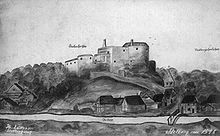Jerome of Efferen
Jerome of Efferen (*, † 27. July 1552 ) was Lord of the sub rule Stolberg and its castle and Jülich bailiff , Vogt , artillery and quartermaster.
family
Hieronymus von Efferen was a son of Vincent von Efferen and thus came from the Overstolz family , one of the oldest patrician families in Cologne . Vincent von Efferen was also already master of Stolberg. Hieronymus' son married Anna von Nesselrode , a great niece of Wilhelm II von Nesselrode , a former subordinate of Stolberg. From this marriage came five sons, among them the Teutonic Knights Wilhelm von Efferen and Johann von Efferen , successor to Hieronymus' wife as master in Stolberg.
The prince-bishop of Worms Wilhelm von Efferen (1563-1616) was Hieronymus' nephew (son of his brother Wilhelm).
Career and work
Hieronymus von Efferen took over the Stolberg fiefdom from his mother Johanna von Merode zu Schloßberg . On September 13, 1541 he was by Duke Johann III. enfeoffed by Kleve and thus confirmed as the subordinate of Stolberg. The first documents that have come down to us from Hieronymus date back to 1526/27, although his mother did not die until 1532.
Jerome's primary interest was to promote Stolberg's economic development . On December 26th, 1532, he gave Johann von Velde the concession to build a copper mill. This was a crucial step in the city's brass industry. The deed was signed by six lay judges and a mayor , the first historical indication that Stolberg owned a mayor's office. A little later, Hieronymus Johann enfeoffed Rave with a mill that later became known as the Ravensmühle.
In addition to the brass trade, which was promoted by the two mills, he was also interested in establishing the extraction and processing of iron. His father had already offered Heinrich Dollart the opportunity to set up a factory in Stolberg. Jerome acquired a third of the hammer. In 1540 he invested in refurbishing the Dollart hammer . Two years later, in 1542, he sold his shares in the work to his liege lord, Duke Wilhelm V of Jülich-Kleve-Berg. Hieronymus was then appointed by the Duke as artillery and equipment master Jülich . As a result, the Dollart hammer became a forge for cannon barrels, rifles and bullets. The place Stolberg flourished economically.
Hieronymus von Efferen had the mining of hard coal in a wooded area in the Stolberg estate promoted since 1539. In 1541, people began to dig for iron ore near the Stolberger Burgfelsen. Hieronymus' attacks on the area to the left of the Vicht in the possession of the imperial abbey Kornelimünster led to disputes, including over the mining rights, which were carried out before the imperial court in Speyer . For this purpose, Egidius von Walschaple created a picture that showed the exact economically significant conditions in the Stolberg Valley, with the existing farm buildings, watercourses, meadows and forests. This representation has been preserved to this day.

During the third War of the Geldr Succession , there was devastation in Stolberg. Soldiers of the Prince of Orange sacked large areas of the city. Parts of the castle were set on fire, the dollar hammer robbed. On the Walschapleschen depiction you can see the castle, which is in the process of being rebuilt, the roofs of which are still missing on the main building.
The Duke of Jülich appointed Hieronymus von Efferen in 1548 as Vogt and bailiff of Wassenberg and bailiff of Heinsberg .
In order to emphasize the independence of Stolberg, he tried to separate the castle chapel from belonging to the parish of Eschweiler . As early as 1533 he asked to have his own priest for his chapel. After the efforts were unsuccessful, he ordered a priest himself to Stolberg. He also created his own cemetery.
death
Hieronymus probably died in a street battle on July 27, 1552 in Heinsberg. According to legend, he tried to ward off a storm of Calvinist citizens on the church there. His tomb was finally erected in the church of St. Gangolf in Heinsberg. The tomb, which was moved from its original location on a pillar of the central nave to the south wall of the south aisle, showed in its central part a relief of a kneeling knight, helmet and gloves laid in front of him and his hands folded in prayer. After it was destroyed by bombs in late autumn 1944, only the lower part of the tomb, the inscription panel, is preserved.
His successor in Stolberg was his wife Anna von Nesselrode.
literature
- Helmut Schreiber: Stolberger Burgherren and Burgfrauen 1118 - 1909. Contributions to the Stolberg history, volume 25. Burg Verlag Gastinger 2001, ISBN 3-926830-16-6
Individual evidence
- ^ Johann Friedrich Schannat : Eiflia illustrata or geographical and historical description of the Eifel , Volume 2, 1st section, Aachen, 1829, pages 88 and 89; Digital scan
- ↑ Paul Clemen (ed.), Karl Franck-Oberaspach, Edmund Renard: The art monuments in the district of Heinsberg (The art monuments of the Rhine province, Volume 8, Section III) . L. Schwann, Düsseldorf 1906, p. 513
Remarks
- ↑ The inscription reads: ESAIAE CAP. 53. REALLY HONOR TAKEN OUR DISEASE AND HAVE ITSELF HAVE CARRIED OUR PAIN. Honor is wounded by our wickedness, and by our great sins will, honor has been crumpled and crushed. HIERONYMUS FROM EFFEREN, HER TO STAILSBURCH; IS GESTORVEN INT JAR 1552; DEN XXVII. JULY. BIT GODT FOR THE SOUL
| personal data | |
|---|---|
| SURNAME | Efferen, Hieronymus von |
| BRIEF DESCRIPTION | Mr. von Stolberg |
| DATE OF BIRTH | before 1527 |
| DATE OF DEATH | July 27, 1552 |

